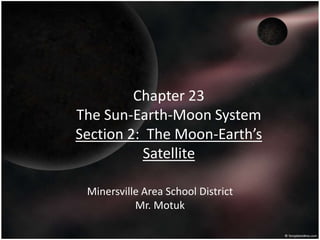
Earth Science Sun, Earth, Moon System
- 1. Chapter 23 The Sun-Earth-Moon System Section 2: The Moon-Earth’s Satellite Minersville Area School District Mr. Motuk
- 2. Section 2: The Moon-Earth’s Satellite A. Motions of the Moon 1. The Moon rotates on its axis. 2. The Moon’s rotation takes 27.3 days with the same side always facing Earth. 3. The moon revolves around the Earth. a. 1 Revolution takes 27.3 days 4. Because the moon revolves around Earth and Rotates at the same rate, this is why we always see the same side of the moon. 5. The moon seems to shine because it reflects sunlight.
- 3. Section 2: The Moon Earth’s Satellite Moon Phases New Moon Waxing Crescent Waning Crescent Waxing Gibbous Waning Gibbous 1st Quarter 3rd QuarterFull Moon
- 4. Section 2: The Moon-Earth’s Satellite B. Moon Phases are the different forms the Moon takes in its appearance from Earth. 1. New Moon-when the moon is between the Earth and the Sun and cannot be seen. 2. Waxing Phases-more of the illuminated half of the moon can be seen each night after the new moon. a. Waxing phases occur between the new moon and the full moon. 3. Full Moon-when all of the Moon’s lighted side is visible from Earth. 4. Waning Phases-Less of the illuminated half of the Moon is visible after the full moon.
- 5. Section 2: The Moon-Earth’s Satellite C. Eight Phases of the Moon 1. New Moon 2. Waxing Crescent a. Right side of moon becomes visible, thin slice. 3. First Quarter a. Right half of the Moon is visible, left half in darkness. 4. Waxing Gibbous a. More than half of the Moon is visible, takes an egg shape.
- 6. Section 2: The Moon-Earth’s Satellite C. Eight Phases of the Moon 5. Full Moon a. When all of the Moon’s surface facing Earth is lit up and visible. 6. Waning Gibbous a. Starts after the full Moon when more then half of the lighted side is still visible. b. Sliver of the right side of the moon is in darkness. 7. Third Quarter (Last Quarter) a. Left half of the Moon is visible, right half is in darkness. 8. Waning Cresent a. Only a sliver of the left side is visible. b. Last visible slice before the new moon.
- 7. Section 2: The Moon-Earth’s Satellite Phases of the Moon
- 9. Section 2: The Moon-Earth’s Satellite D. Eclipses- when the Earth or moon casts a shadow on the other. 1. Solar Eclipse: The moon moves directly between the Earth and Sun, shadowing part of the Earth. a. Under the UMBRA, or darkest part of the shadow, a total solar eclipse occurs. i. Only the corona is seen glowing during a total solar eclipse. (see next slide) b. A partial solar eclipse happens in the lighter shadow on Earth’s surface called the penumbra. c. A total solar eclipse is visible only on a small area of Earth.
- 10. Section 2: Solar Eclipse 1. Solar Eclipse (continued) d. Blocks the view of the sun. e. Occur during New Moon f. Occur every year, only seen in specific areas.
- 11. Section 2: Solar Eclipse Images of Solar Eclipses Total Solar Eclipse Partial Solar Eclipse
- 12. Section 2: The Moon-Earth’s Satellite D. Eclipses- when the Earth or moon casts a shadow on the other. 2. Lunar Eclipse: When Earth’s shadow falls on the moon. a. If the moon is completely in Earths umbra, a total lunar eclipse occurs. b. Partial Lunar Eclipse: When only part of the Moon moves into Earth’s umbra, or the moon is totally in the penumbra. c. Total Lunar Eclipses must occur during a full moon! d. A total lunar eclipse is visible in the nighttime side of the Earth when the night is clear.
- 13. Section 2: Lunar Eclipse
- 14. Section 2: The Moon-Earth’s Satellite E. The Moon’s Surface 1. Has many depressions or craters, formed from meteorites, asteroids, and comets. 2. Cracks in the Moon’s crust caused lava to fill large craters forming maria, or dark flat areas. 3. Highlands are areas on the moon of light colored crust. 4. Igneous maria rocks are 3 to 4 billion years old, indicating craters formed after the surface cooled. 5. Lunar dirt called REGOLITH (rock particles and dust) a. This is not soil because it contains no water or organic matter.
- 15. Section 2: The Moon-Earth’s Satellite E. The Moon’s Surface 6. Data from moonquakes suggest that under the Moon’s crust might lie a solid mantle, then a partly molten mantle and a solid, iron rich core. F. The Impact Theory of Moon Origin 1. The Moon formed 4.6 billion years ago from Earth material thrown off when a large object collided with Earth.
- 16. Section 2: The Moon-Earth’s Satellite G. Moon Data 1. The Moon’s average day time temperature is 214*F. 2. The Moon’s average night time temperature is -300 *F 3. Moon’s gravity is 6X lighter than the Earth’s. 4. The Moon has no atmosphere so it is always black there. 5. Moon’s diameter is 2160 miles.